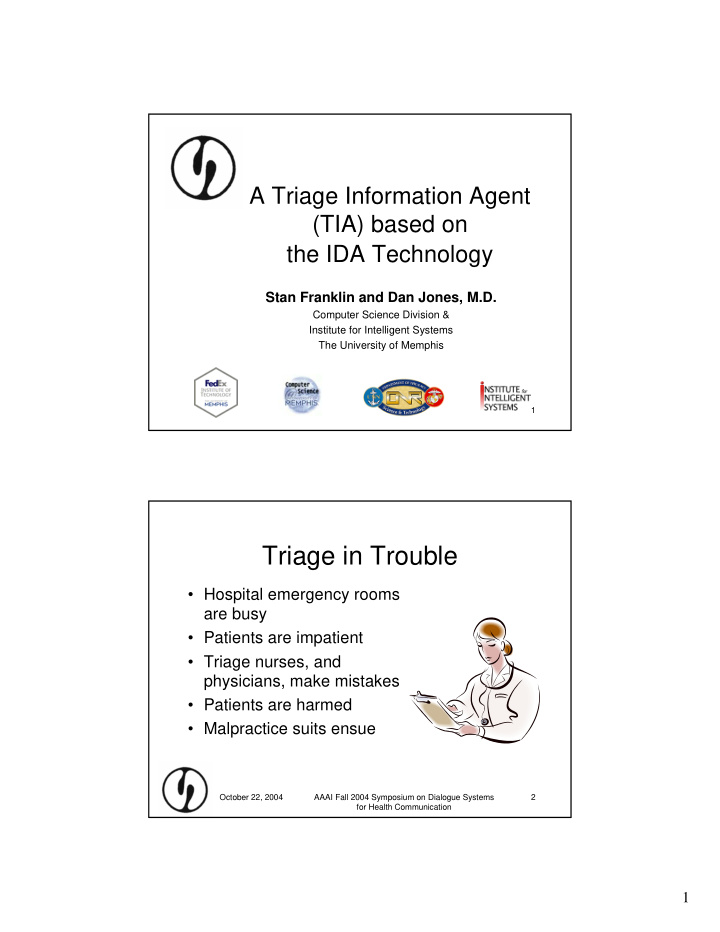



A Triage Information Agent (TIA) based on the IDA Technology Stan Franklin and Dan Jones, M.D. Computer Science Division & Institute for Intelligent Systems The University of Memphis 1 Triage in Trouble • Hospital emergency rooms are busy • Patients are impatient • Triage nurses, and physicians, make mistakes • Patients are harmed • Malpractice suits ensue October 22, 2004 AAAI Fall 2004 Symposium on Dialogue Systems 2 for Health Communication 1
TIA to the Rescue � Triage nurse rules out an immediately life-threatening situation � Patient dialogues with TIA � TIA passes information and recommendations � Nurse observes, interviews & schedules initial testing � Convert a 2-step patient to a 1-step patient October 22, 2004 AAAI Fall 2004 Symposium on Dialogue Systems 3 for Health Communication From TIA to the Triage Nurse � Patient demographics, condition, chief complaint � Differential diagnosis, recommendations for � Prioritization � Non-physician care (testing) October 22, 2004 AAAI Fall 2004 Symposium on Dialogue Systems 4 for Health Communication 2
My Research Directions • How do minds work? – Human minds – Animal minds – Artificial Minds • How to make smart software agents? – Copy them after humans October 22, 2004 AAAI Fall 2004 Symposium on Dialogue Systems 5 for Health Communication The IDA Project • IDA finds new jobs for sailors • Negotiates in colloquial English • Adheres to Navy policies • Automates task of a human detailer • Cutting edge software agent technology • Employs diverse “new AI” mechanisms • Models animal and human cognition • Hypotheses for cognitive scientists and neuroscientists October 22, 2004 AAAI Fall 2004 Symposium on Dialogue Systems 6 for Health Communication 3
The IDA Modules for TIA • Perception • Language generation • Working memory • Deliberation • Semantic memory • Volition • “Consciousness” • Diagnosis • Action selction October 22, 2004 AAAI Fall 2004 Symposium on Dialogue Systems 7 for Health Communication IDA suffices for TIA • TIA can be implemented on the IDA technology • Much knowledge engineering needed • Some basic research – Differential diagnosis – Interfacing with voice recognition October 22, 2004 AAAI Fall 2004 Symposium on Dialogue Systems 8 for Health Communication 4
Goals for TIA • Shorten patient time in the emergency room – TIA initiates routine non-physician care actions – Converts 2-step patients into 1-step patients – Decreases the time a physician spends with patients • Decrease triage-related errors and malpractice risk – Reduce prioritization errors leading to errors of delay – Reduce errors of oversight or omission October 22, 2004 AAAI Fall 2004 Symposium on Dialogue Systems 9 for Health Communication Issues of Concern • Will patients willingly interact with TIA? • Quality of voice recognition software • Variety of patient’s – incapacity due to illness/stress – intelligence level – English fluency • Knowledge engineering costs October 22, 2004 AAAI Fall 2004 Symposium on Dialogue Systems 10 for Health Communication 5
TIA as an idea • So far, high-level planning only • One partner at remote location and otherwise occupied • No intention to seek funding • Willing to collaborate with other interested parties October 22, 2004 AAAI Fall 2004 Symposium on Dialogue Systems 11 for Health Communication Email and Web Addresses • Stan Franklin – franklin@memphis.edu – www.cs.memphis.edu/~franklin • “Conscious” Software Research Group – www. csrg.memphis.edu/ October 22, 2004 AAAI Fall 2004 Symposium on Dialogue Systems 12 for Health Communication 6
Recommend
More recommend